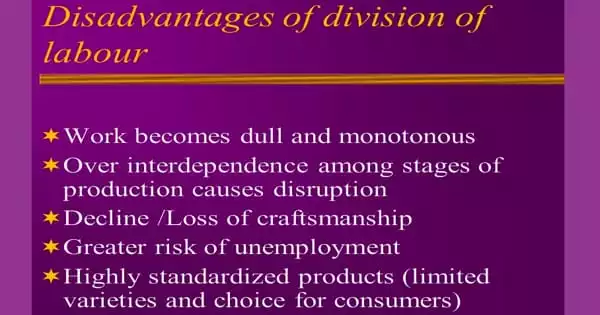The division of labor has a variety of substantial benefits. However, there are a number of drawbacks to be aware of. Despite the fact that the benefits are still overwhelming, it is critical to identify the drawbacks and learn how to reduce them.
The division of labor refers to task segmentation, with each individual focusing on a distinct element of the manufacturing process. The disadvantages of division of labor are so significant that one must carefully analyze both possibilities before deciding whether to use or avoid division of labor.
(1) Boredom from Repetition
While focusing on a single activity can boost productivity, it can also lead to monotony and boredom. Doing the same thing over and over again with no challenge is not conducive to the human condition. We are wired to seek advancement and purpose. Some occupations are more boring than others. Consider standing in the center of a factory, putting things in a box on a regular basis. Some people may love such jobs, while others may become disinterested. However, overall productivity may fall and turnover rates may rise. Nonetheless, productivity rates are still advanced when compared to the pre-division of labor.
One of the ways by which employers counter-act boredom is either through performance-based bonuses, higher pay, or performance checks. The success of which depends on how and where they are implemented.
(2) Interdependence
When tasks are divided across many departments/employees, a level of interdependence is generated. For example, the making of a simple pencil is divided into multiple steps. Someone has to mine the granite, someone else has to cut the wood, someone else has to make the rubber, and someone else has to put it all together.
Nobody involved in the process actually understands how the pencil is manufactured, but everyone is involved in its production. At the same time, the final result is dependent on timely material delivery. If one portion of the process is disrupted, whether by a strike or a natural calamity, the entire chain can come apart.
(3) Lack of Responsibility
It can be difficult to assign blame when each person is simply a small element of a larger chain. When a task fails, determining what went wrong can be time-consuming. At the same time, it becomes simpler for some people to slack off.
When one person creates X amount of output, it is easily quantifiable. However, when they are part of a larger process, it is impossible to quantify the end result. As a result, some employees may not accept as much responsibility for task failure.
(4) Lack of Craftsmanship
Workers are not artisans as a result of the division of labor. They are educated to generate only pieces of items rather than complete products. That example, no single employee can claim to understand all of the procedures involved in the production of a product.
Workers may become bored if they are required to perform the same duty all the time and over and over again. It may also be unchallenging, suffocating workers’ initiatives.
(5) Over-dependence among Workers
A worker is completely dependent on other workers in a division of labor situation. Each worker’s duty is critical to the production process, to the point that a worker’s absence from work may cause production to stop.
When a worker’s skill set is no longer required, he may be made redundant. Transferring him to execute another work becomes difficult because he is a specialist in one task.
















